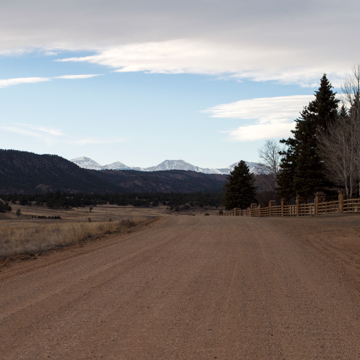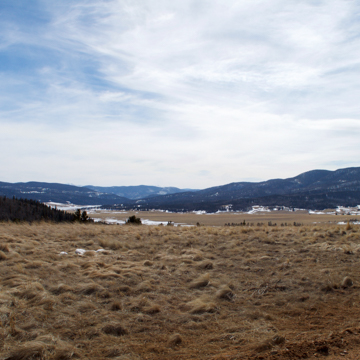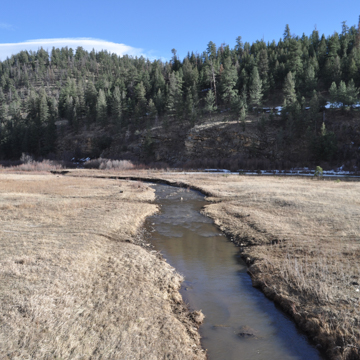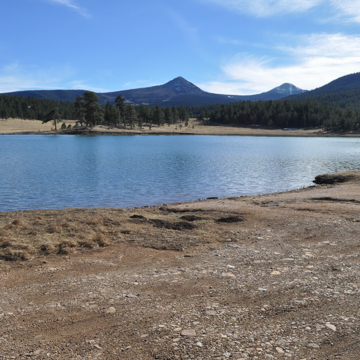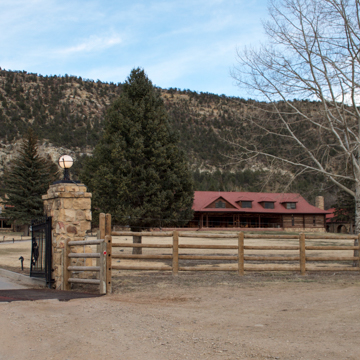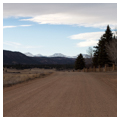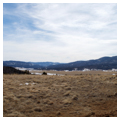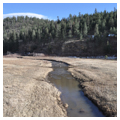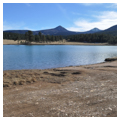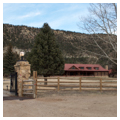The Vermejo Park Ranch maps a complex history of land ownership and development that starts with a nineteenth-century Mexican land grant and extends across the twentieth century to the present day. Established in 1902 when William Bartlett acquired 220,000 acres from the Maxwell Land Grant, the ranch now occupies nearly 600,000 acres in northern New Mexico and southern Colorado. Extending from Park Plateau in the Raton Basin through the Sangre de Cristo subrange of the Rocky Mountains, at elevations ranging from 5,850 to about 13,000 feet, it is the largest privately owned single property in the country. Rich in natural gas and replete with wildlife and vegetation, Vermejo Park Ranch has become an elite destination for hunting, fishing, and ecotourism under its current owner, Ted Turner Enterprises.
Native Americans first inhabited the fertile lands of the Park Plateau from about 400 CE until the Great Drought of 1276 to 1299. Navajo and Jicarilla Apache Indians migrated into the region in the late fifteenth century, establishing small rural communities called rancherías along the Vermejo River until they were forced out by Ute and Comanche raiders in the early nineteenth century. When the Santa Fe Trail opened in 1821, it passed through Vermejo en route to Santa Fe, attracting fur trappers and both Mexican and American settlers to the region.
In 1841, the Mexican government granted 1,714,765 acres of land in northern New Mexico and southern Colorado to the French-Canadian fur trapper Carlos Beaubien and the Mexican official Guadalupe Miranda. The largest land grant in what became part of the United States in 1848, it got its name after Beaubien’s daughter, Luz Beaubien, and son-in-law, Lucien Maxwell, inherited the grant in 1864. They sold the property in 1870 to a group of investors who established the Maxwell Land Grant and Railway Company, which sold and leased land to farmers, ranchers, and miners. In 1902, the Chicago businessman William H. Bartlett purchased 220,000 acres of Maxwell land, priced between $0.30 and $1.00 per acre, to develop an exclusive mountain retreat for family, friends, and business associates.
Drawn to the region to help his son, William Jr., recover from tuberculosis, Bartlett first built a cottage in 1903 on the north side of the Vermejo River. This served as a temporary residence for Bartlett’s family, who moved to Vermejo Park in the summer of 1903. In 1907, Bartlett commissioned the Chicago-based architect Joseph Lyman Silsbee to design larger and more permanent stone structures. The Casa Minor (1907) and Casa Grande (1908–1909) combine the Mission Style with locally sourced sandstone, timber, and red tiled roofs. At the same time, Bartlett commissioned Silsbee to expand the original cottage and design cottages for a resident doctor, secretary, and superintendent, and began to develop the site for hunting and fishing excursions. He repopulated the area with elk, created a series of lakes from natural depressions on the plateau, and built the original Costilla Lodge, a high mountain fishing camp at the foot of the Sangre de Cristos, in 1915.
After Bartlett’s death in 1918, the ranch passed to his sons, Norman and William Jr. When they died unexpectedly in 1919 and 1920, William Jr.’s wife, Virginia, inherited the property, which she sold in 1926 to the Vermejo Club, an exclusive hunting, fishing and recreational club whose members included President Herbert Hoover and the financier Andrew Mellon. The club dissolved during the Great Depression, and Vermejo Park was leased as a private cattle ranch until 1948. Purchased along with adjacent lands by the Texas industrialist W.J. Gourley, Vermejo Park grew to 480,000 acres. Gourley again repopulated the ranch with elk, turkeys, and buffalo, restocked its lakes, restored the original stone structures, and then reopened the ranch to guests as a mountain retreat in 1952.
Following Gourley’s death in 1970, his widow sold Vermejo Park to the Pennzoil Corporation, which established the subsidiary Vermejo Park Corporation to manage the ranch and its guest operations from 1973 until 1996. Pennzoil donated 100,000 acres of property to the Carson National Forest, and also expanded Vermejo Park to nearly 600,000 acres by purchasing 190,000 acres from the Kaiser Steel Company. In 1990–1991, the Vermejo Park Corporation constructed the 20,000-square-foot Main Lodge between the Casa Minor and Casa Grande, on the site of the 1903 Bartlett residence, destroyed by fire in 1955.
Ted Turner Enterprises purchased Vermejo Park Ranch in 1996. This became Turner’s largest property and made him the second largest private landowner in the United States with over two million acres. Besides continuing the ranch operations as an exclusive hunting, fishing, and wildlife retreat, Turner has initiated conservation, restoration, forestry, and wildlife management programs aimed at restoring the ranch’s natural ecosystems, increasing its biodiversity, and maintaining its sustainability. With a landscape that ranges from flat prairie to mountain tundra, the ranch is home to over 180 bird species and sizeable populations of black bears, mountain lions, and Rocky Mountain bighorn sheep, and maintains large herds of elk, deer, pronghorn antelope, and bison. In 2001, Vermejo Park Ranch became part of a cooperative effort with the State of New Mexico and the State of Colorado to restore the endangered native population of Rio Grande cutthroat trout, and has worked to maintain the region’s native Ponderosa pine forests.
In 2010, Turner commissioned the Santa Fe firm of Conron and Woods to replace the deteriorating Costilla Lodge with a new structure, and in 2012–2016 undertook the restoration of Casa Grande.
The Casa Minor, Casa Grande, Costilla Lodge and private guesthouses offer lodging and accommodations. Vermejo Park Ranch is a gated private property, but is open to ranch guests year round.
References
“Costilla Lodge.” Conron & Woods Architects. Accessed March 11, 2016. http://www.nmmagazine.com.
Herndon, Dave. “A Turning Point in Turner Country.” New Mexico Magazine, June 2015.
Laurie, Karen P. “History of Vermejo Park, New Mexico.” New Mexico Geological Society Guidebook, 27th Field Conference, 1976. Socorro: New Mexico Geological Society, 1976.
Pappas, Mike J. Raton: History Mystery and More. Coda Publications, 2003.
Turner Enterprises, Inc. “History.” Vermejo Park Ranch. Accessed March 11, 2016. http://vermejoparkranch.com/.
Zimmer, Steve. Vermejo Park Ranch: A History. Raton, NM: Vermejo Park, L.L.C., 2009.





